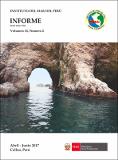Por favor, use este identificador para citar o enlazar este ítem:
https://hdl.handle.net/20.500.12958/3213| Título : | Morfología y sedimentos superficiales del fondo marino de las islas Ballestas y Chincha. Marzo 2015 |
| Otros títulos : | Morphology and superficial sediments of the bottom of the Ballestas and Chincha Islands. March 2015 |
| Autor : | Velazco Castillo, Federico Solís Acosta, Juana Calderón, Iván |
| Palabras clave : | Sedimentos marinos;Morfología;Fondo marino;Islas Ballestas - Ica |
| Fecha de publicación : | 2017 |
| Editorial : | Instituto del Mar del Perú |
| Citación : | Inf Inst Mar Perú 44(2), 2017, p. 284-296 |
| Citación : | Informe IMARPE;44(2), 2017 |
| Resumen : | Los sedimentos que rodean los fondos rocosos de
las islas Ballestas y Chincha, caracterizadas por la elevada pendiente de sus laderas, están constituidos
por depósitos de bloques, guijas, gravas y arenas cuya composición es lítica y biogénica (fragmentos de
caparazones de moluscos). Los contenidos de materia orgánica total (MOT) son mínimos (alrededor de 1%)
y los carbonatos totales (CBTOS) superan el 50% en ambas islas. Los depósitos de arena presentan variada
selección dependiendo de su distancia a la fuente de aporte y las corrientes marinas. Estos depósitos por
ubicarse al pie de las laderas submarinas de las islas, (guijas de forma angular), se identifican como depósitos
de gravedad con poco transporte. La litología corresponde a rocas ígneas intrusivas alcalinas, denominadas
granitos. También se detectó guijas redondeadas, que podrían corresponder a erosión de formaciones
conglomeradas presentes en la zona acantilada y muy próxima a los depósitos submarinos. Alejándose de
los depósitos de partículas gruesas y en las depresiones, superficie del fondo con escasa inclinación, y en
áreas protegidas de las corrientes que proporcionan los afloramientos rocosos, se encuentran sedimentos
de granulometría más fina (mayores proporciones de limo y arcilla sobre arena), los contenidos de materia
orgánica total (MOT) alcanzan hasta 15,04% en sedimento de textura fango en islas Ballestas y 18,52% en
sedimento de textura limo arenoso en islas Chincha. ABSTRACT: Sediments surrounding the rocky bottoms of the Ballestas and Chincha Islands, characterized by a high inclination of the slopes, consist of deposits of blocks, pebbles, gravels and sands. Whose composition is lytic and biogenic (fragments of shells of mollusks). the content of total organic matter (TOM) are minimal (around 1%) and total carbonates are more than 50% in both islands. The deposits of sand present a variety of selection depending on the distance to the source of contribution and the ocean currents. These deposits placed at the foot of the submarine slopes of the islands, (angle-shaped pebbles), are identified as granite deposits. Rounded pebbles were also detected, which could correspond to erosion of conglomerate formations present in the cliffs and very close to the undersea deposits area. Moving away from the deposits of thick particles and in depressions, the bottom surface with low inclination, and in areas protected from the currents which provide the rocky outcrops, are sediments from finer particle size (greater proportions of silt and clay over sand). The contents of total organic matter (TOM) reach to 15.04% in mud sediment texture in Ballestas islands and 18.52% in silt sediment texture in Chincha Islands. |
| URI : | https://hdl.handle.net/20.500.12958/3213 |
| ISSN : | 03787702 |
| Aparece en las colecciones: | Informe Vol. 44(2) 2017 |
Ficheros en este ítem:
| Fichero | Descripción | Tamaño | Formato | |
|---|---|---|---|---|
| Informe 44(2)8.pdf | 6 MB | Adobe PDF |  Visualizar/Abrir |
Este ítem está sujeto a una licencia Creative Commons Licencia Creative Commons

